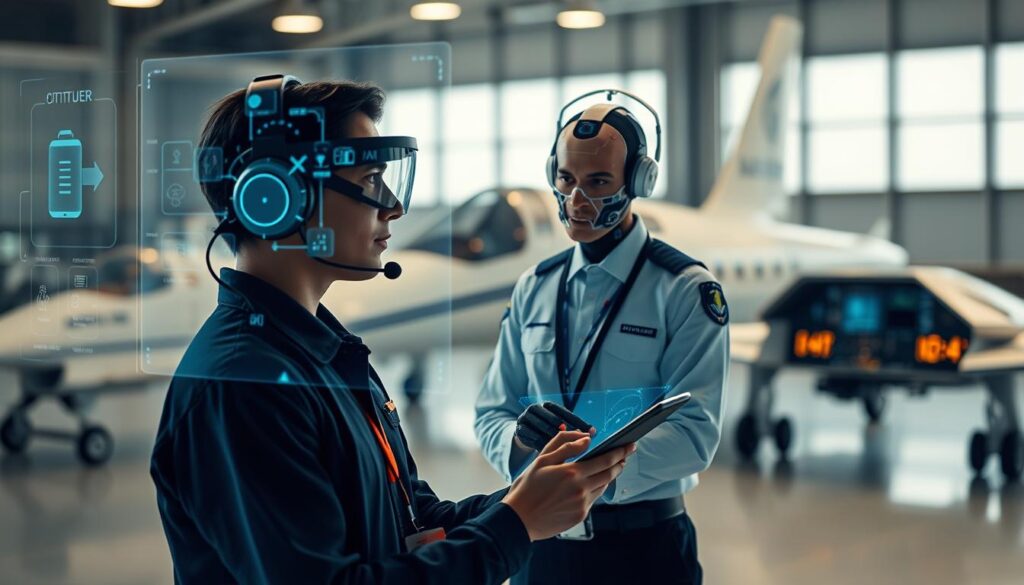During the pandemic, the aerospace industry faced a 2.8% revenue drop, according to the Aerospace Industries Association. Despite this setback, remarkable achievements like NASA’s Ingenuity Mars flight and SpaceX’s civilian ISS mission showcased the sector’s resilience.
However, challenges remain. A study by Iowa State University revealed significant workforce retention issues among aerospace students. At the same time, the push for net-zero carbon aviation solutions is creating a demand for a skilled workforce.
Organizations like Springs of Dreams Corp. are addressing these gaps by engaging middle school students in aerodynamics education. These efforts highlight the importance of early exposure to future aerospace careers.
Key Takeaways
- The aerospace industry saw a 2.8% revenue decline during the pandemic.
- NASA’s Ingenuity Mars flight and SpaceX’s civilian ISS mission are notable achievements.
- Workforce retention issues among aerospace students are a growing concern.
- Net-zero carbon aviation solutions require a skilled workforce.
- Early education programs are essential for inspiring future aerospace professionals.
How Online Learning is Transforming Aviation and Aerospace Education
Digital platforms are reshaping how aviation professionals gain expertise. Traditional classrooms are being replaced by innovative tools that enhance aerospace education. This shift is not just a trend but a necessity in a rapidly evolving industry.
The Shift from Traditional to Digital Classrooms
Gone are the days when students relied solely on textbooks and lectures. Today, technologies like virtual reality and e-learning platforms are taking center stage. For example, Jeppesen’s e-learning platform has reduced traditional classroom time by 40%, making learning more flexible and efficient.
British Airways uses Full Flight Simulators to replicate A380 cockpit experiences. These simulators provide a controlled environment where pilots can practice without risks. Such advancements are setting new standards in flight training.
Benefits of Online Learning for Flight Training
Online platforms offer numerous advantages. Airbus’ augmented reality maintenance guides have reduced technician errors by 27%. Similarly, CAE’s data-driven pilot training analyzes over 500 performance metrics per session, ensuring precision.
Cost savings are another major benefit. A $15 million simulator can replace $100 million in actual aircraft training costs. Additionally, the Pilot Training System boasts a 92% exam pass rate, compared to the traditional average of 78%.
With FAA approval for virtual reality hours counting toward instrument ratings, the future of aerospace education looks promising. These innovations are not just improving skills but also making training more accessible and affordable.
Key Technologies Driving Change in Aerospace Training
Cutting-edge tools are transforming how professionals prepare for aerospace careers. From immersive simulations to adaptive learning systems, these innovations are setting new benchmarks in training efficiency and effectiveness.
Virtual Reality and Immersive Simulations
Virtual reality is revolutionizing aerospace training by providing realistic, hands-on experiences. Lockheed Martin uses VR to train satellite repair technicians, reducing the need for costly extravehicular activity (EVA) practice. Similarly, Lufthansa’s VR cabin crew training simulates over 200 emergency scenarios, ensuring preparedness in high-pressure situations.
NASA’s Computational Fluid Dynamics (CFD) program has reduced wind tunnel testing by 60% through advanced simulations. This integration of VR not only saves time but also enhances precision in training.
Augmented Reality for Real-Time Skill Development
Augmented reality is another game-changer, offering real-time guidance during training. United Airlines implemented an AR checklist system, improving pre-flight inspection speed by 35%. PlaneEnglish ARSim has boosted radio communication proficiency by 43% in just six weeks.
These tools provide a controlled environment where trainees can practice without risks, ensuring better skill retention and application.
AI and Machine Learning in Adaptive Curriculum Design
Artificial intelligence and machine learning are reshaping how training programs are designed. MIT’s AI-driven curriculum adapts to student error patterns in real-time, offering personalized learning paths. This approach ensures that trainees focus on areas needing improvement, maximizing efficiency.
The FAA’s new XR certification standards, set to be implemented in 2024, further highlight the growing role of AI in aerospace training. These advancements are making education more accessible and tailored to individual needs.
For more insights into modern training methods, explore pilot training software development.
The Rise of Flight Simulators in Pilot Training
Flight simulators are becoming a cornerstone in modern pilot training. These advanced tools provide a realistic and controlled environment for pilots to hone their skills. From reducing costs to enhancing safety, simulators are transforming how pilots prepare for real-world challenges.
Full Flight Simulators vs. Traditional Training
Traditional training methods often involve expensive aircraft and limited practice scenarios. In contrast, flight simulators like the CAE 7000XR can reduce jet transition training from six months to just eight weeks. This efficiency is a game-changer for aspiring pilots.
For example, actual 737 training costs around $850 per hour, while simulator sessions cost only $230. This significant cost difference makes simulators a more accessible option for training programs. Additionally, simulators allow pilots to practice rare but critical scenarios, such as stall recoveries, which have seen a 300% increase in simulations since the 2019 Lion Air crash investigation.
Cost and Safety Advantages of Simulator Use
Simulators offer both financial and safety benefits. EASA now requires 50% of ATPL certification hours to be completed in simulators, reflecting their growing importance. This shift not only reduces costs but also ensures pilots are better prepared for emergencies.
Delta Airlines’ use of hurricane simulations improved pilot decision-making by 68%. Similarly, Textron’s AI copilot, trained on over 10,000 simulator sessions, enhances in-flight safety. The FAA’s “Zero Accident” initiative leverages predictive analytics from simulators to identify and mitigate risks before they occur.
For more insights into how simulators are shaping pilot training, explore VR flight simulators.
Personalized Learning: The Role of AI and Data Analytics

Artificial intelligence is reshaping how pilots and technicians train. By leveraging machine learning and data analytics, the aerospace industry is creating tailored learning experiences that improve efficiency and outcomes.
Boeing’s predictive algorithms have reduced type rating training time by 22%. Airbus’ Skywise platform tracks over 150 data points per maintenance trainee, ensuring precision in skill development. These advancements highlight the power of data analytics in modern training programs.
GE’s engine diagnostic training uses real-time flight data streams to simulate real-world scenarios. This approach allows trainees to practice in a controlled environment, enhancing their problem-solving skills. Similarly, Emirates’ AI tutor has reduced recurrent training failures by 41%, showcasing the effectiveness of adaptive learning systems.
- Pratt & Whitney’s VR modules adapt to individual spatial awareness, ensuring personalized training paths.
- ICAO’s new competency-based training standards require AI tracking to measure progress accurately.
- UTC’s adaptive exams dynamically adjust question difficulty based on trainee performance.
These innovations are not just improving the learning experience but also setting new benchmarks for efficiency and accessibility in aerospace training. By integrating artificial intelligence and machine learning, the industry is ensuring that every trainee receives the support they need to succeed.
Challenges of Implementing Online Learning in Aviation
Adopting digital tools in aviation training comes with its own set of challenges. While these platforms offer flexibility, they must meet strict regulatory standards and ensure safety remains a top priority. Balancing theory with hands-on practice is another hurdle institutions face.
Regulatory Hurdles and Certification Standards
One major obstacle is the lengthy approval process for digital training programs. For example, the FAA Part 141 school certification takes 14-19 months on average. EASA’s 2023 VR certification requirements were delayed by 18 months, slowing integration of advanced tools.
Organizations like AOPA are pushing for standardized XR equipment certification to streamline approvals. However, NTSB reports show that 12% of trainees experience VR motion sickness, raising concerns about widespread adoption.
Bridging the Gap Between Theory and Practical Skills
Another challenge is ensuring trainees retain practical skills. EAA studies found a 34% drop in skill retention with pure virtual training. To address this, ICAO now mandates blended learning programs that include physical checkrides.
Bombardier’s hybrid program combines VR training with actual taxi tests, offering a balanced approach. This method ensures trainees gain both theoretical knowledge and hands-on experience.
For more insights into these challenges, explore distance learning in aviation education.
Case Studies: Successful Online Training Programs

Innovative training programs are setting new standards in the aviation and aerospace industry. These initiatives are not only enhancing learning experiences but also addressing critical skill gaps. Let’s explore some standout examples that are transforming the way professionals prepare for their careers.
Boeing’s Pilot Development Program
Boeing’s program is a leader in flight training, graduating 650 pilots annually with a 98% placement rate. The curriculum includes a six-month VR-based upset recovery module, which has significantly improved pilot readiness. This immersive approach allows trainees to practice rare but critical scenarios in a safe environment.
By leveraging advanced technologies, Boeing ensures that graduates are well-prepared for real-world challenges. The program’s success highlights the importance of integrating cutting-edge tools into traditional training methods.
NASA’s CFD Training Innovations
NASA’s Computational Fluid Dynamics (CFD) program has trained over 1,200 engineers in 2022 alone. Their virtual wind tunnel is used by 47 universities worldwide, providing students with hands-on experience in aerodynamics. This tool has reduced the need for physical wind tunnel testing by 60%, saving time and resources.
NASA’s approach demonstrates how digital tools can enhance learning experiences while maintaining rigorous standards. For more insights into similar programs, explore GE Aerospace’s commitment to learning and.
- Airbus’ AR programs have increased maintenance certifications by 300%.
- Embraer’s AI instructor reduces jet transition time by 30%.
- Collins Aerospace’s virtual avionics lab serves over 15,000 students globally.
These case studies showcase the transformative power of modern training programs in the aerospace industry. By embracing innovation, organizations are ensuring a skilled and prepared workforce for the future.
The Future of Online Learning for Aviation and Aerospace
Advancements in technology are reshaping how aerospace professionals prepare for their careers. From immersive simulations to collaborative virtual classrooms, the industry is embracing innovative solutions to meet growing demands. These tools are not just enhancing training but also addressing critical skill gaps.
Integration of Extended Reality (XR)
Extended Reality (XR) is transforming aerospace education. Rolls-Royce’s XR turbine training has reduced instructor costs by 62%, making it a cost-effective solution. Similarly, Honeywell’s metaverse campus trains over 50,000 professionals annually, offering immersive learning experiences.
Supersonic jet training simulations now use real-time weather AI to replicate challenging conditions. This approach ensures pilots are prepared for any scenario. Textron’s blockchain-based credentialing system is also streamlining certification processes, making them more secure and efficient.
Global Collaboration in Virtual Classrooms
Virtual classrooms are fostering global collaboration in aerospace training. ICAO’s 2025 Virtual Global Classroom initiative involves 87 nations, creating a unified learning platform. IATA’s virtual air traffic control project spans 22 countries, enhancing cross-border cooperation.
These initiatives are breaking down geographical barriers, allowing professionals to learn from experts worldwide. The FAA predicts that by 2030, 70% of training will be simulator-based, further emphasizing the importance of integration in modern education.
By leveraging machine learning and augmented reality, the industry is ensuring a skilled workforce ready to tackle future challenges. These innovations are setting new standards in aerospace training, making it more accessible and effective.
Conclusion
Balancing technology with hands-on training is essential in modern aerospace education. Programs like Springs of Dreams Corp.’s aerodynamics demonstrations show the value of practical learning. While VR adoption is projected to reach 63% by 2026, the FAA emphasizes the need for in-person checkrides to ensure skill retention.
Hybrid models, like Dassault’s training program, reduce carbon footprints by 28% while maintaining rigorous standards. Iowa State’s findings highlight how adaptive learning experiences improve persistence among students. Emirates’ 2030 vision for fully personalized pilot pathways further underscores the industry’s commitment to innovation.
The aerospace industry must continue integrating advanced tools while preserving hands-on practice. This balanced approach ensures a skilled workforce ready for the challenges of future aerospace careers.

